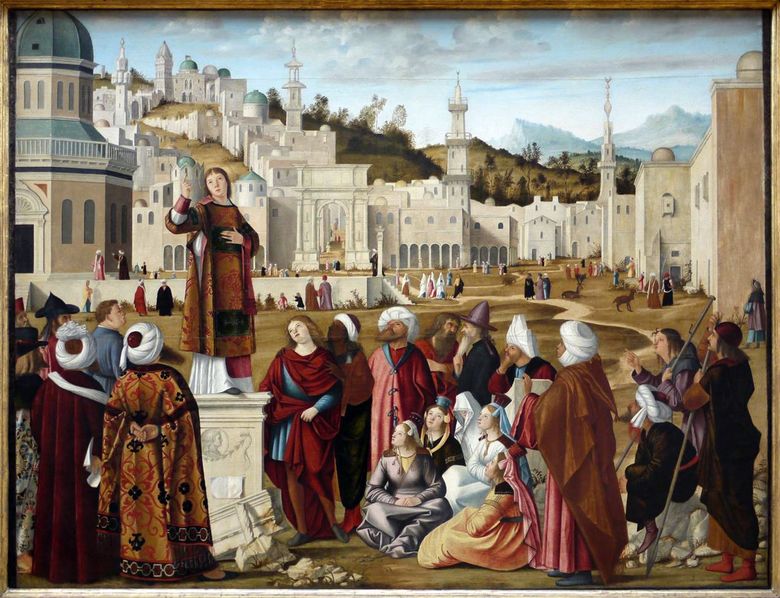
A series of paintings by Carpaccio, dedicated to the life of St. Stefan and written for the theological school “Scuola di Santo Stefano” in Venice, was started in 1511. Carpaccio depicts Stephen, clothed in the clothes of a deacon in the XVI century. and preaching before the meeting of attentive listeners. He stands on the pedestal of an ancient statue, which symbolizes the victory of Christianity over paganism.
A figure with a veiled face behind a group of seated women is an allusion to the popular Christian allegory, representing Judaism in the form of a woman with a blindfold, blind and deaf to the good news of the Gospels; The men behind her are probably the members of the council of the Jewish community, who blamed Stefan for blasphemy.
The octagonal Baptistery behind Stefan’s back speaks of the imminent triumph of Christianity. SW. STEPHEN. Stephen is revered as the first Christian deacon and martyr. The legend tells that Stefan’s relics were taken to Rome and placed in the tomb of St. Laurentia. When the tomb was opened, Lavrenti moved to give Stefan a place.
In Italian and French Renaissance paintings, Stephen is often portrayed as a young deacon with the attribute of this saint – a stone that served as an instrument of his martyrdom. In the narrative cycle of the frescoes of Fra Angelico in the chapel of Nicholas V in Rome, he is depicted together with St. Laurentius.
 Arrival of Saint Ursula and pilgrims to Cologne by Vittore Carpaccio
Arrival of Saint Ursula and pilgrims to Cologne by Vittore Carpaccio Birth of the Virgin Mary by Vittore Carpaccio
Birth of the Virgin Mary by Vittore Carpaccio Preaching of St. Stephen in front of the gates of Jerusalem by Vittore Carpaccio
Preaching of St. Stephen in front of the gates of Jerusalem by Vittore Carpaccio Saint Stephen prêchant – Vittore Carpaccio
Saint Stephen prêchant – Vittore Carpaccio Miracle relics of the Holy Cross by Vittore Carpaccio
Miracle relics of the Holy Cross by Vittore Carpaccio Meeting of Saint Ursula and pilgrims with the Roman Pope Kyriak by Vittore Carpaccio
Meeting of Saint Ursula and pilgrims with the Roman Pope Kyriak by Vittore Carpaccio San Stephen predicando – Carpaccio Vittore
San Stephen predicando – Carpaccio Vittore St. Jerome leads to the monastery of the lion by Vittorio Carpaccio
St. Jerome leads to the monastery of the lion by Vittorio Carpaccio